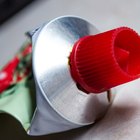
Cooks are faced with a mixed bag when it comes to storing tomatoes. Those kept at room temperature taste better than those stored in the refrigerator. But chilled tomatoes can last twice as long as those kept on the counter or in a pantry. Reconcile the dilemma without seeing red, knowing that wherever you keep tomatoes, they won’t last forever. No one wants to contract a foodborne illness, so learn to recognize when tomatoes have gone bad.
Step 1
Check the condition of the tomato skin. Fresh tomatoes are firm and taut; bad tomatoes look puckered and wrinkled, and the skin may be cracked or split in places.
Step 2
Inspect the tomato for signs of mold, including black or dark green splotches and white fuzz. A waxy film on the tomato can also be a sign of trouble.
Step 3
Pick up a tomato to see whether it’s leaking liquid from the bottom. Like a once plump balloon, bad tomatoes often go soft and limp, then ooze a liquid that might resemble vegetable oil.
Step 4
Smell the tomato. A bad tomato may exude a putrid, bitter or otherwise foul aroma, especially near the stem.
Step 5
Throw away tomatoes that look or smell bad. Trust your instincts and err on the side of playing it safe.
Related Articles

Fresh Tomatoes vs. Canned

How to Get Rid of Blackheads With ...

How to Know if Beef Cubes Are Bad

How to Store Alfalfa Sprouts

How to Soften Tomatoes

How to Store Tomatoes

How to Skin Cherry Tomatoes

How to Tell if Mozzarella Is Bad

Tomato, Cooked or Raw, & Lycopene

How to Store Shallots

How to Get Rid of Irritation From ...

Yogurt Face Mask for Acne

How to Get Rid of Bumps From Plucking

How to Tell When Tortellini Is Bad

How to Treat a Bad Bikini Line Rash

How Long Does Tomato Juice Last After ...

How Can You Tell If Frozen Shrimps Are ...

When Is Bok Choy Bad?

How to Get Rid of a Bump on Your Nose ...

If Chicken Smells Bad Can You Still ...
References
Resources
Tips
- Minimize the flavor loss from refrigerated tomatoes by keeping them in the crisper section for no longer than three days. Put them in a paper bag and keep them away from meat, poultry, fish and other foods that could leak.
- Store fresh tomatoes under a glass dome or in a paper bag in a cool spot and out of the path of direct sunlight.
- Confront fruit flies by putting a small bowl of white vinegar next to your tomatoes. Drawn to this aroma, the curious flies will meet a hasty and liquid demise.
Writer Bio
Mary Wroblewski earned a master'sdegree with high honors in communications and has worked as areporter and editor in two Chicago newsrooms. She launched her ownsmall business, which specialized in assisting small business ownerswith “all things marketing” – from drafting a marketing planand writing website copy to crafting media plans and developing emailcampaigns. Mary writes extensively about small business issues, andespecially “all things marketing.”
Photo Credits
Michael Blann/Digital Vision/Getty Images